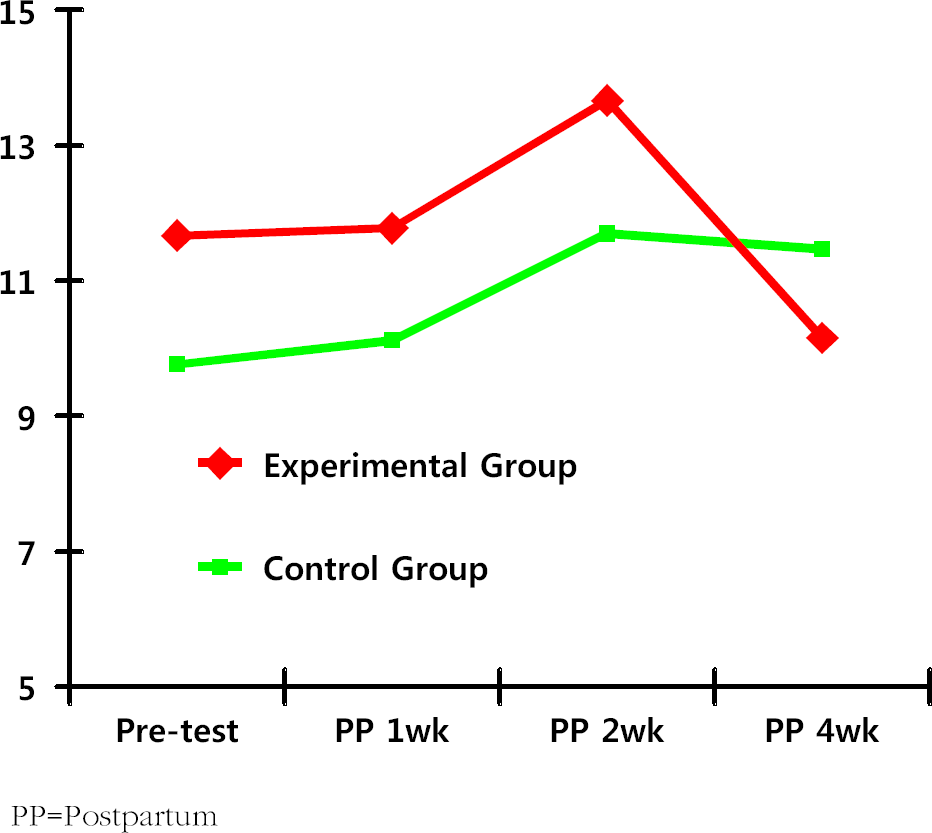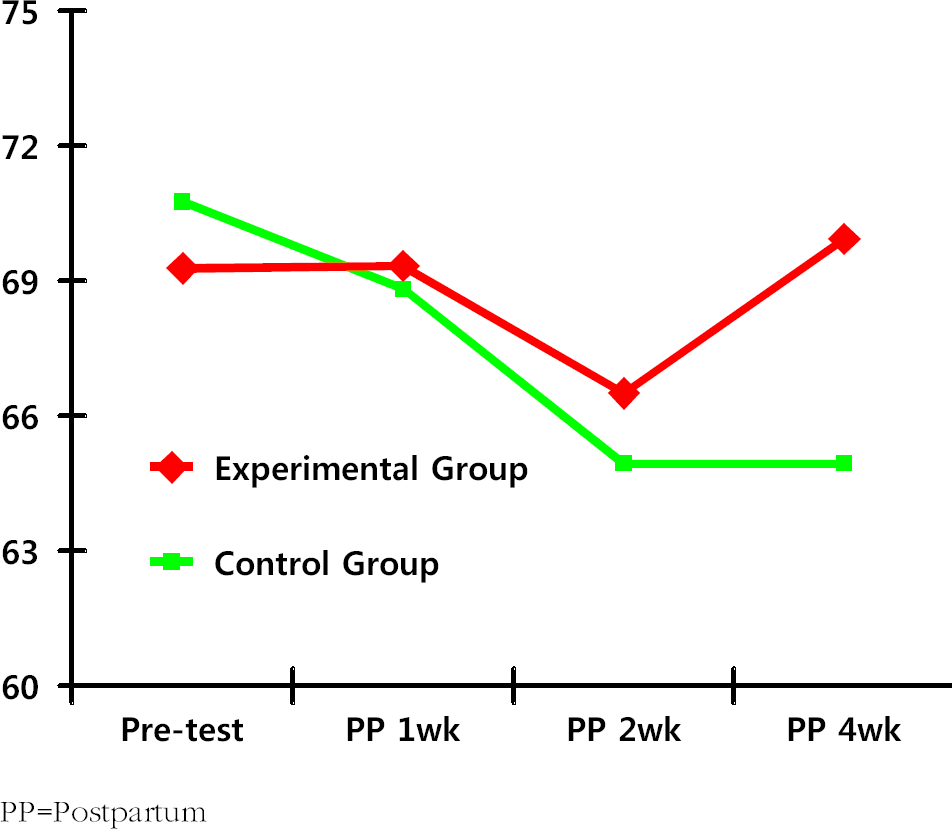Abstract
Purpose
This study examine theeffectsof music therapy and phone counselingonpostpartumdepression and maternal identity in high risk women.
Methods
A nonequivalent control group time series research design was employed. Eighteenwomencomprised theexperimentalgroupandseventeenwomen, the control group. Experimental group received 4 weeks of music therapy and phone counseling. Postpartum depression and maternal identityweremeasuredprior tointerventionandonthe 1st, 2nd, and 4th weeks after its introduction.
Results
The first hypothesis (i.e.,“the degree of postpartum depression would be lower inthe experimental group thaninthe control group in amonth'stime”) was not supported(z=-0.47, p=.641). Thesecondhypothesis(i.e.,“the degree of maternal identitywould belower in the experimental group than in the controlgroupina month”) was not sup-portedas well(z=1.08, p=.285).
Conclusion
Thereis the needtomonitor long-termeffects of musictherapy and phone counselingonhighriskpostpartumwomen, beyond 4 weeks observed inthisstudy. Additionally, the development of musictherapytailoredtohighriskindividualsandsystematicphonecounselingprotocolsfor postpartum depression is required.
Go to : 
References
1. Shin HC. Health Insurance Review & Assessment Service Policy Brief [Internet]. Seoul: Health Insurance Review and Assessment Service;2012. [Trend analysis of high risk pregnancy, childbirth related medical use]; [cited 2013 Oct 25 ]; p.p. 51–60. Available from:. http://www.hira.or.kr/ebook/7d8c1ff2-586c–42c8-a82d–08e6adadbab9/120614_Page_img/extra/120614.pdf.
2. National Institute of Child Health and Human Development. What are the factors that put a pregnancy at risk? [Internet]. Rockville: National Institute of Child Health and Human Development;; [updated 2013 Oct 22; cited 2013 Oct 25 ]. Available from:. http://www.nichd.nih.gov/health/topics/high-risk/conditioninfo/pages/factors.aspx.
3. Kim SO. Postpartum depression and maternal identity of the high risk women [master's thesis]. Gangneung: Kwandong University;2009.
4. Kim HW, Jung YY. Influencing factors on antenatal depression. Korean J Women Health Nurs. 2010; 16(2):95–104. http://dx.doi.org/10.4069/kjwhn.2010.16.2.95.

5. Kim HW, Jung YY. Effects of antenatal depression and antenatal characteristics of pregnant women on birth outcomes: a prospective cohort study. J Korean Acad Nurs. 2012; 42(4):477–85. http://dx.doi.org/10.4040/jkan.2012.42.4.477.

6. Brandon AR, Trivedi MH, Hynan LS, Miltenberger PD, Labat DB, Rifkin JB, et al. Prenatal depression in women hospitalized for obstetric risk. J Clin Psychiatry. 2008; 69(4):635–43.

7. Robertson E, Grace S, Wallington T, Stewart DE. Antenatal risk factors for postpartum depression: a synthesis of recent literature. Gen Hosp Psychiatry. 2004; 26(4):289–95. http://dx.doi.org/10.1016/j.genhosppsych.2004.02.006.

8. Brooten D, Youngblut JM, Brown L, Finkler SA, Neff DF, Madigan E. A randomized trial of nurse specialist home care for women with high-risk pregnancies: outcomes and costs. Am J Manag Care. 2001; 7(8):793–803.
9. Beck CT. Theoretical perspectives of postpartum depression and their treatment implications. MCN Am J Matern Child Nurs. 2002; 27(5):282–7.

10. Centersfor DiseaseC, Prevention.Prevalence of self-reported postpartum depressive symptoms–17 states, 2004–2005. MM WR Morb Mortal Wkly Rep. 2008; 57(14):361–6.
11. Kim JW, Kim JH, Eun DS, Kim H. Psychosocial and obstetric predictors of depressive symptomatology at postpartum 4 weeks. Korean J Obstet Gynecol. 2005; 48(4):901–9.
12. Ahn YM, Kim MR. The effects of a home-visiting dischargeeducation on maternal self-esteem, maternal attachment, postpartum depression and family function in the mothers of NICU infants. J Korean Acad Nurs. 2004; 34(8):1468–76.
13. Henshaw C, Foreman D, Cox J. Postnatal blues: a risk factor forpostnatal depression. JPsychosomObstet Gynaecol. 2004; 25(3–4):267–72.
14. Kim HW, Hwang MS, Hong KJ. Primipara's maternal identity & self confidence for caring the baby during the immediate postpartum period. Korean J Women HealthNurs. 1998; 4(1):65–77.
15. Ahn YM, Kim JH. Comparison of maternal self-esteem, postpartal depression, and family function in mothers of normal and of low birthweight infants. J Korean Acad Nurs. 2003; 33(5):580–90.

16. Logsdon MC, Wisner KL, Pinto-Foltz MD. The impact of postpartum depression on mothering. J Obstet Gynecol Neonatal Nurs. 2006; 35(5):652–8. http://dx.doi.org/10.1111/j.1552–6909.2006.00087.x.

17. Chae YS. Adaptation of maternal roles and postpartum depression of primiparas during early postpartum period. J Clin Nurs. 2005; 8:113–24.
18. Kim JI.A validation study on the translated Korean version of the Edinbergh postnatal depression scale. Korean J Women Health Nurs. 2006; 12(3):204–9.
19. Kim JI. Related factors to postpartum care performance in postpartum women. J Women Health Nurs. 2007; 13(2):98–104.

20. Shin HJ. Maternal transition in mothers with high risk newborn [dissertation]. Seoul: Korea University;2002.
21. Lee SM. Theeffectsof music therapyonpostpartum blues and maternal attachment of puerperal women. J Korean Acad Nurs. 2010; 40(1):60–8. http://dx.doi.org/10.4040/jkan.2010.40.1.60.
22. Galinsky MJ, Schopler JH, AbellMD.Connecting groupmem-bers through telephone and computer groups. Health Soc Work. 1997; 22(3):181–8.
23. Thome M, Alder B. Atelephoneintervention to reduce fatigue and symptom distress in mothers with difficult infants in the community. J Adv Nurs. 1999; 29(1):128–37.
24. Dennis CL, Hodnett E. Psychosocial and psychological interventions for treating postpartum depression. Cochrane Database Syst Rev. 2007; 4:CD006116. http://dx.doi.org/10.1002/14651858.CD006116.pub2.

25. Ugarriza DN, SchmidtL.Telecarefor womenwithpostpartum depression. J Psychosoc Nurs Ment Health Serv. 2006; 44(1):37–45.
26. Beck CT. Predictors of postpartum depression: an update. Nurs Res. 2001; 50(5):275–85.
27. Lee YH. The relations between attribution style, life events, event attribution, hopelessness and depression [dissertation]. Seoul: Seoul National University;1993.
28. Kim HW, Hong KJ. Development of a maternal identity scale for pregnant women. J Korean AcadNurs. 1996; 26(3):531–43.

29. Choi BC. Music Therapy. Seoul: Hakjisa;2002.
30. Thefree dictionary [Internet]. Huntingdon Valley(PA): Farlex, Inc.;c2012. Telephone counseling; [cited 2013 Dec 3]. Available from:. http://medical-dictionary.thefreedictionary.com/telephone+counseling.
31. Kang SJ. The effects of phone counseling on maternal role in primiperous mothers [master's thesis]. Seoul: Yonsei University;1998.
32. The free dictionary [Internet]. Huntingdon Valley(PA): Farlex, Inc.;c2012. Music therapy; [cited 2013 Dec 3]. Available from:. http://medical-dictionary.thefreedictionary.com/music+therapy.
33. Cohen J. Statistical power analysis for the behavioral sciences. 2nd ed.New Jersey: Lawrence Erlbaum Associates;1998.
34. Ahn OS, Oh WO. Relationship among postpartum depression, parenting stress and self-esteem inmothers during puerperium. J Korean Soc Matern Child Health. 2006; 10(1):58–68.
Go to : 
Table 1.
Research Design
| Postpartum | Experimental group | Control group | |||
|---|---|---|---|---|---|
| Pretest | Procedure | Posttest | Pretest | Posttest | |
| ≤ 3 days | O1 | O1 | |||
| 1 week | X | O2 | O2 | ||
| 2 weeks | X, X1 | O2 | O2 | ||
| 4 weeks | X, X1 | O2 | O2 | ||
Table 2.
Analysis of Homogeneity in General Characteristics (N=35)
Table 3.
Analysis of Homogeneity in Pregnant and Postpartum Characteristics (N=35)
Table 4.
Analysis of Homogeneity in Postpartum Depression, Maternal Identity between Experimental and Control Group at Pretest (N=35)
| Variables | Exp. (n=18) | Cont. (n=17) | z | p |
|---|---|---|---|---|
| M±SD | M±SD | |||
| Postpartum depression | 11.67±7.97 | 9.76±6.80 | –0.746 | .456 |
| Maternal identity | 69.28±11.50 | 70.76±10.87 | –0.480 | .632 |
Table 5.
Differences in Postpartum Depression, Maternal Identity between Experimental and Control Group (N=35)
Table 6.
Repeated Measure ANOVA in Postpartum Depression, Maternal Identity (N=35)




 PDF
PDF ePub
ePub Citation
Citation Print
Print




 XML Download
XML Download